Ryan Hall's Blog, page 244
June 14, 2016
ASICS Unveils Lightweight, Responsive DynaFlyte Trainer
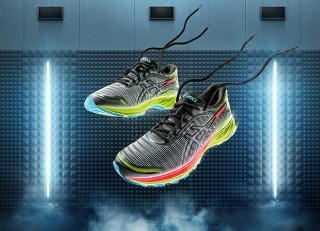
The key component of the new ASICS DynaFlyte is the lightweight and responsive FlyteFoam midsole. Photo: Courtesy of ASICS
A year ago ASICS unveiled the MetaRun, which most observers at the time dubbed a “concept shoe.” With only a few thousand units produced and a $250 price tag, it was obvious the Japanese shoe brand wasn’t targeting the MetaRun at a mass audience, but rather using it as a vehicle to strut their design technology stuff, the way auto makers do at the yearly auto shows. And to be sure, the MetaRun incorporated some half dozen design features aimed at making it lighter, more responsive, and more stable.
Now, what was perhaps the most significant of those innovations, the FlyteFoam midsole material, has made its debut in a mainstream production model, the DynaFlyte. With the shoe, ASICS has broken the 300g barrier for cushioned shoes; a men’s size 9.0 tips the scales at 270g or 9.5 ounces. (A women’s size 7.0 is 221g or 7.8 oz.) In a comparison with blown rubber EVA, the midsole material in most shoes, FlyteFoam is about 55 percent lighter.
Additionally, the proprietary material has organic fibers mixed in, which serve to limit the amount of deformation that occurs under load. This has the effect of making the DynaFlyte both cushioned and stable, a seemingly contradictory achievement that has been the Holy Grail of shoe designers for years.
Strategically placed forefoot flex grooves provide the DynaFlyte with flexibility that might be unexpected in a full-length midsole of FlyteFoam.
At this morning’s rollout event in New York City, Ryan Hall, the retired American marathoner, noted that he particularly liked the added cushioning when he runs on the roads, especially since he is now carrying an extra 20 pounds of muscle from his new weight lifting regimen, while sprinter Candace Hill, who recently turned pro after becoming the first high school girl to break 11 seconds for the 100 meters, said it’s the only training flat she tried that allowed her to run workouts using sprint form.
The DynaFlyte will be available July 1 with a $140 price tag.
The post ASICS Unveils Lightweight, Responsive DynaFlyte Trainer appeared first on Competitor.com.
Mother Breaks Record for Fastest Half Marathon Pushing a Stroller

It’s the year of fast stroller running.
The Guinness World Record for fastest half marathon by a female pushing a stroller was broken earlier this month, as 37-year-old Lindsy James of the United Kingdom smashed the previous record—which stood for 15 years.
James’ blistering time of 1:27:34 at the Ramathon in Derby, England broke the previous record—held by American Nancy Schubring since 2001—by more than 3 minutes.
Lindsy ran with her 8 ½-month old son in the stroller, averaging 6:41 per mile the entire way. Her husband, Owen, ran with them (and recorded the entire race on a GoPro, uploading it on YouTube) along with two independent witnesses.
“I lost my mum last year to cancer and I wanted to do something to raise as much money as possible for charity,” Lindsy told the Derby Telegraph. “We wanted to do something fairly high profile and we thought to break a world record would be a huge challenge.”
Lindsy was raising funds for Macmillan Cancer Support.
Her record-setting performance comes just a few months after Calum Neff of Texas broke the men’s record with a 1:11:27 time (5:27 per-mile pace) that won the Katy Half Marathon in February.
The post Mother Breaks Record for Fastest Half Marathon Pushing a Stroller appeared first on Competitor.com.
Photos: Real Athlete Diets Healthy Cooking Class
There is nothing quite like enjoying a great meal with good people. That’s truly understood when you learn how to make the meal together, especially one that’s not only delicious but also good for you as an athlete. So it was at the recent Eat Like an Athlete cooking class offered by chefs Casey Easton of Food Lab culinary school and Kelly Bailey Newlon of Real Athlete Diets in Boulder, Colo. They created a fresh and healthful menu of four incredibly tasty dishes and demonstrated just how to prepare them. On this night, 16 participants took the challenge, honed their skills and whetted their appetites and dined on amazing cuisine.
RELATED: Eat Like an Athlete: A Colorado Food Business That Fuels Performance
Here’s a sneak peek inside the class.
Photo Gallery
1 of {count}
Back to Start
View Larger Image

Eat Like and Athlete Cooking Class at Food Lab
Food Lab culinary school in Boulder, Colo., holds numerous classes and dinners, with themes including sushi, paella, and fresh pasta to various ethnic cooking nights ranging from Thai, Cuban, Italian, Puerto Rican and more.
View Larger Image

Eat Like and Athlete Cooking Class at Food Lab
If you're going to a kitchen to make delicious food, you should certainly bring your appetite! This beautiful table setting is what greeted participants at the Real Athlete Diets event at Food Lab.
View Larger Image

Eat Like and Athlete Cooking Class at Food Lab
Even the hors d'oeuvres were healthy—and of course, very tasty!
View Larger Image

Eat Like and Athlete Cooking Class at Food Lab
Kelly Bailey Newlon (left) and Casey Easton gave participants a bit about their background, both as chefs and athletes, and explained some of the methods to their own personal madness in the kitchen and how whole foods can help athletes with performance and recovery.
View Larger Image

Eat Like and Athlete Cooking Class at Food Lab
Each participant was presented with the evening's menu and a very sharp knife.
View Larger Image

Eat Like and Athlete Cooking Class at Food Lab
The chefs chose menu items that are flexible enough to be easily adapted to suit any one of the many dietary options—vegan, paleo, vegetarian, or omnivore. Beans could readily sub in for the chicken, the turkey meatballs equally delicious with saffron rice, and the pork chorizo ragout could just as tastily be chicken chorizo or even tofu.
View Larger Image

Eat Like and Athlete Cooking Class at Food Lab
The group of 16 participants broke into smaller groups to ensure we all played a role in the creation of our meal: slicing, dicing, stirring and mashing.
View Larger Image

Eat Like and Athlete Cooking Class at Food Lab
Some of the participants looked like well-trained professionals.
View Larger Image

Eat Like and Athlete Cooking Class at Food Lab
Just as in sports, there is camaraderie in cooking. We all had fun trying to follow recipes and prepare dishes—including the twice baked sweet potatoes with cilantro pesto and
chipotle chicken (or chipotle beans for the vegetarian palate).
View Larger Image

Eat Like and Athlete Cooking Class at Food Lab
That's the start of the coconut harissa vegetable side dish.
View Larger Image

Eat Like and Athlete Cooking Class at Food Lab
Scott Jurek (center), the author of "Eat and Run: My Unlikely Journey to Ultramarathon Greatness," showed he has the culinary skills and kitchen wit to match his ultrarunning talents.
View Larger Image

Eat Like and Athlete Cooking Class at Food Lab
Although a few of the participants knew their way around the kitchen already, there was plenty to be learned from Kelly and Casey.
View Larger Image

Eat Like and Athlete Cooking Class at Food Lab
Those are avocado bison meatballs cooking away at 350 degrees.
View Larger Image

Eat Like and Athlete Cooking Class at Food Lab
By the time we put the finishing touches on the twice baked sweet potatoes with cilantro pesto and
chipotle beans, we were all quite hungry and ready to eat.
View Larger Image

Eat Like and Athlete Cooking Class at Food Lab
When the meal was ready to eat, Peter Downing, an ultrarunner and co-founder of Suffer Better, gave a few words of thanks. It's hard to say what aspect of the evening was better—the process of cooking together with interesting and engaging people, good conversations, laughter and learning, or the utter joy of gathering for the group meal when the cooking was all said and done. Plus, we all walked away with several simple, delicious and healthful recipes to enhance our training. Ultimately, it was all good—food, people, community.
View Larger Image

Real Athlete Diets Cooking Class at Food Lab
Proceeds from the evening benefited Boulder's Chef Ann Foundation, an organization helping schools serve children healthy and delicious scratch-cooked meals made with fresh, whole food.
View Larger Image

Eat Like and Athlete Cooking Class at Food Lab

More Galleries
The post Photos: Real Athlete Diets Healthy Cooking Class appeared first on Competitor.com.
12 July Races to Sign Up For

Photo: Courtesy of the San Francisco Marathon
Take advantage of warmer weather with a growing number of 5K, half marathon, marathon and trail races that will challenge your overall fitness and have you sweating. Just remember to hydrate!
Marathon/Half Marathon
Saratoga Springs Half Marathon
July 10; Saratoga Springs, N.Y.
Known for its horse racing, Saratoga Springs is a scenic small town nestled in the Adirondack region of upstate New York. This half marathon course is relatively flat and fast, mostly in Saratoga Spa State Park. A relay and 5K run is also available, and overall and age-group winners receive a pint glass.
Rock ’n’ Roll Chicago
July 17; Chicago
The Rock ’n’ Roll tour makes a stop in Chicago with a half marathon that offers an impressive tour of downtown and the Lakefront. The race starts and ends in Grant Park, with live music along the route to keep you going. Then enjoy a post-race concert from the headlining band Echosmith.
The San Francisco Marathon
July 31; San Francisco
Experience one of America’s most beautiful cities with this course that takes you along the scenic San Francisco waterfront and over the Golden Gate Bridge. You can choose from the full marathon, a half (the first or second half of the race), 5K or even a 52.4-mile double marathon.
The post 12 July Races to Sign Up For appeared first on Competitor.com.
8 Trail-Tested Essentials
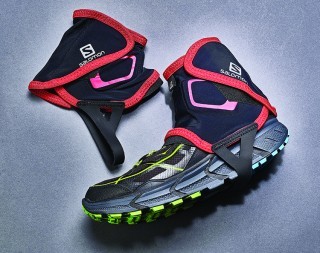
Mild temperatures, warm sunshine and dry trails make summer prime time to run your favorite off-road routes. Before letting wanderlust be your guide, be sure to update your kit with some of these trail essentials.
Photos: Mark Doolittle
Photo Gallery
1 of {count}
Back to Start
View Larger Image

Patagonia Duckbill Trucker Hat, $35
Trucker hats with performance characteristics are the latest must-have accessory. This one has a wicking headband and mesh back to dump heat, plus a dark underbill to reduce glare. It can even fold to fit into your pocket without losing its shape.
View Larger Image

Julbo Zephyr, $130
If you were to to make a list of features you want in running sunnies, these would check all the boxes. With photochromic lenses, full coverage, adjustable temples that stay in place without giving you a headache, ventilation and an adjustable nosepiece, you’ll forget you’re wearing them!
View Larger Image

UV Buff National Park NP Rocky Mountain, $25
A trail running staple, the latest UV Buffs celebrate the 100th anniversary of the National Park Service with designs representing six of the most iconic parks. In addition to blocking 95 percent of UV rays and controlling odor, 3 percent of every purchase is donated to the American Hiking Society.
View Larger Image

Altra StashJack, $130
Functional and unique, this wind- and water-resistant jacket
stores in a waist pack and is easy to put on as you go. Here’s the crazy part: It has an open back to fit over your pack, meaning no stopping and futzing with gear when bad weather rolls in. It even has a hood.
View Larger Image

Outdoor Research Sensor Dry Pocket Armband, $45
For those who run without a pack, finding a safe way to carry your phone can be a struggle. Consider the problem solved with a waterproof armband that fits comfortably and securely, leaving your hands free for scrambling. It also works with headphones.
View Larger Image

Montane VIA Armguard, $25
Make temperature adjustments on the fly with lightweight sleeves. Breathable and fast drying, the fabric (made from recycled coffee grounds) also offers UPF 50+ and odor control, and feels cool to the touch.
View Larger Image

Salomon Trail Gaiters High, $42
Keep rocks, mud, snow, sand and any other unwanted trail debris outside your shoes with these handy gaiters for happy feet. They go on over shoes and wrap around your ankles.
View Larger Image

Stance Fleshman OTC Socks, $36
Road and track speedster, author, and co-founder of Picky Bars Lauren Fleshman collaborated with Stance to adorn socks with her own inspired designs. The art on this over-the-calf style is an ode to the trails in her hometown of Bend, Ore. (Available July 1)
Related Galleries

8 Off-Road Essentials

More Galleries
The post 8 Trail-Tested Essentials appeared first on Competitor.com.
4 Energizing Trail Mix Recipes for On-The-Go
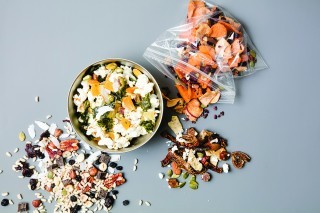
Photo: Courtesy of Velopress
Trailblazers have long relied on trail mix for its simple yet energy-dense qualities. The following gussied-up versions from Canadian dietitian Matthew Kadey’s latest recipe book, “Rocket Fuel: Power-Packed Foods for Sports + Adventure,” prove that trail mix doesn’t have to be restricted to just peanuts and raisins. “Items like trail mix are cherished by the outdoor crowd, so my goal was to give it some new spins,” says Kadey, whose book provides more than 80 simple and quick homemade fuel recipes for the everyday athlete.
RELATED: Fueling Tips and Recipes for Before, During and After a Workout
Dairy-free, Gluten-free, Vegan or Vegetarian
Servings: 8
Active time: 10 min.
Bulk bins are a great place to locate items such as dried fruit and nuts in just the right portions you need for making trail mix.
Cherry Haze
2 cups brown rice crisps or puffs
½ cup halved hazelnuts
½ cup pecans
½ cup dried cherries
½ cup dried blueberries
½ cup dark chocolate chips
1/3 cup unsweetened flaked coconut
¼ cup raw shelled pumpkin seeds (pepitas)
Tropical Twister
4 cups plain popcorn
½ cup chopped dried mango
½ cup chopped dried pineapple
½ cup unsalted shelled pistachios
½ cup roughly chopped unsalted dry-roasted cashews
1/3 cup unsweetened flaked coconut
¼ cup wasabi peas
2 nori sheets, torn into small pieces
Crunchy Apple
2 ounces sweet potato chips, roughly broken apart (about 1 cup)
1½–2 ounces plain or cinnamon apple chips, roughly broken (about ¾ cup)
1 cup roughly chopped walnuts
¾ cup dried cranberries
1/3 cup raw shelled pumpkin seeds (pepitas)
¼ cup cacao nibs
Gourmet Pizza
2–3 ounces herb crackers, broken into ½-inch pieces*
2–3 ounces pepperoni or other cured meat such as jerky, chopped
2 ounces feta cheese, crumbled (about ½ cup)
½ cup unsalted roasted almonds
½ cup sliced dried figs
½ cup thinly sliced sun-dried tomatoes (not oil packed)
¼ cup raw shelled pumpkin seeds (pepitas)
* Add crackers no more than 2 days before
serving to keep them crisp.
Do it yourself!
Place all of the ingredients for each trail mix combination in a large bowl and toss to combine. Divide mixture among zip-top bags for transport. Mixes can be made up to three days in advance and kept in the refrigerator for longer-lasting freshness.
Recipes republished with permission from “Rocket Fuel” by Matt Kadey, RD. Learn more at Velopress.com/rocketfuel.
The post 4 Energizing Trail Mix Recipes for On-The-Go appeared first on Competitor.com.
Salomon Running TV: Down
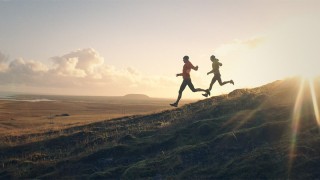
In the latest episode of Salomon Running TV, British fell runners Ricky Lightfoot and Tom Owens head to Iceland looking to tap into the exhilaration of downhill running.
The post Salomon Running TV: Down appeared first on Competitor.com.
Workout of the Week: Plus Ones
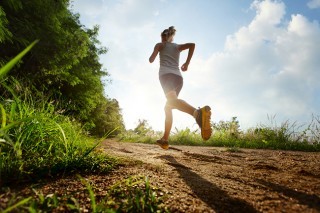
This workout is challenging, but will also give your fitness -- and confidence -- a nice little boost heading into your next race.. Photo: www.shutterstock.com
This workout helps improve two crucial elements of racing well.
Everyone has their favorite go-to workouts, whether it’s a set of lung-searing track intervals, a tried-and-true tempo run, or a fartlek session you’ve done so many times you could complete it blindfolded. These are the key sessions help improve both fitness and confidence as you build toward a goal race.
The Plus One workout adds a slight twist to two of my favorite interval sessions, The Halftime Fartlek and a similar doozy I like to call Descend The Ladder, and helps improve two crucial elements of racing well: 1. The ability to maintain goal race pace when your legs are trashed, and 2. The ability to shift gears and finish strong. The basic structuring of the sessions involves inserting a faster interval into the main interval set. For those faster repetitions, I usually prescribe a minute — or if on the track, a lap — hence the name of the workout.
Below I describe two workouts geared toward athletes focusing on racing 5K/10K, but either session can be easily manipulated in regard to the length and intensity of the intervals in order to work for longer distances or lesser experience levels. Do these workouts once or twice in the 2-4 weeks preceding a key race when your overall workload is still fairly high. These two sessions are challenging, but will also give your fitness—and confidence—a nice little boost heading into your next race.
Here’s how to do them:
Off The Track:
— Warm up with 15-20 minutes of easy jogging, followed by dynamic stretching, drills and strides.
— Perform a timed fartlek of 5-1-4-1-3-1-2-1-1-1 minute repetitions. Run the non-bolded reps (5-4-3-2-1) at 5K-10K race effort, jogging for half the time of the last interval you completed as recovery, so 2:30 jogging after the 5-minute intervals, 2 minutes after the 4-minute interval, etc. Run the bolded 1-minute repetitions at 10-15 seconds per mile faster than 5K-10K race effort. Follow the faster 1-minute reps with 3 minutes of easy jogging before moving on to the next rep.
— Cool down with 15-20 minutes of easy jogging.
On The Track:
— Warm up with 15-20 minutes of easy jogging, followed by dynamic stretching, drills and strides.
— Perform a descending ladder of 2,000-400-1,600-400-1,200-400-800-400-400-400 meter intervals. Run the non-bolded reps (2K-1,600-1,200-800-400) at 10K race pace, jogging for half the distance of the last interval you completed as recovery, so a 1,000m jog after the 2,000m interval, 800m after the 1,600m interval, etc. Run the bolded 400m repetitions at 5K race pace or slightly faster. Follow the faster 400m reps with 400m of easy jogging (preferably going in the other direction on the track) before continuing down the ladder.
The post Workout of the Week: Plus Ones appeared first on Competitor.com.
June 13, 2016
Why Your Upper Back Hurts When You Run

At the end of a long hard run, you expect your legs and lungs to be burning, but your upper back? No way.
Unfortunately, “it’s a very common thing,” said Nick Studholme, a sports chiropractor in Colorado. As the intensity and length of a run increases, many runners will often experience a worsening sharp pain in their upper back, in between or under the shoulder blades. It’s not quite debilitating, but it sure is painful and annoying.
It’s particularly common in novice runners, said physical therapist Ben Shatto, but it can happen to anyone with poor technique or weak back muscles. And that’s most of us.
“Most people don’t get coaching on technique,” said Studholme, so we often have flaws in our form, which worsen as we fatigue.
As we get tired, our head tends to lean ahead of our body. This is generally for two reasons, said Studholme. Either we’re fatiguing and hyperextending the lower back, which leads to jutting the head forward. Or we’re essentially doing the opposite and slouching. Either way, once our head is in front of our body it puts pressure and weight on our upper back.
“It’s like a bowling ball on a stick,” said Shatto. That bowling ball is easier to hold when it’s straight up and down. But if you’re trying to hold it out at an angle in front of you, well, that’s harder. “It takes a lot of muscle to hold it up.”
The challenge with simply correcting your head position, said Studholm, is that if the other things that led to that aren’t fixed, then pretty soon you’ll be right back where you started.
There are other technique issues, too, that can contribute to upper back problems. We can hold our arms too high or too tight. Especially as we tire, our shoulders tend to rise and become tenser. Some of us swing our arms too much; some of us not enough. Studholm said, generally, he recommends an arm swing where your fist is next to your hip at one end of the swing and your elbow at the other. Many of us cross our body with our arms, creating torque on the upper back.
RELATED: Is There an Ideal Running Form?
Of course, diagnosing pain is never simple.
“Just because you have pain at x, y, z spot, doesn’t mean that’s the origin of your pain,” said Thomas Hyde, professor of sports medicine at University of Western States.
Hyde cites an example of a study where researchers looked at the fascia, connective tissue under the skin, in cadavers. When the fascia at the bottom of the spine was tugged on, it caused a counter-reaction felt in the opposite shoulder. If you’re feeling pain in your upper back when you run, it could actually be because of issues lower down the chain.
There’s also some research about the pain caused by peripherally sensitive nerves just under the skin, said Studholme. With repetitive motion, those nerves can get caught up in the tissue, which creates irritation. One of the things that makes those nerves so sensitive to irritation are changes in pH in that region. What one thing causes a change in pH? Lactic acid. Studholme said there’s some growing evidence that when local nerves are bathed in lactic acid, for example as you run longer or harder, that can make them more sensitive to irritation and ultimately cause pain. There are topical gels that can bring down the localized pH and taping methods that stop some of the nerves from getting stuck in the tissue. But then you’re still back to ground zero: fixing whatever caused the irritation in the first place.
For Shatto, fixing that initial issue is challenging. Much of our slouching, and the accompanying stress on our upper backs and shoulders, is “a function of society.” Runners aren’t different from everyone else these days—meaning that we spend lots of time sitting in front of computers or bent over our phones. “You’re always hunched over something,” said Shatto. That adds stress to the vertebrae and ligaments in our neck, shoulders, and back. We can deal with it most of the time, but when we start running it becomes too much.
“Those muscles get tired,” said Shatto.
Shatto recommends a series of exercises to strengthen the lower and mid trapezius muscles, and the rhomboid muscles, along the spine at the base of the neck, like shoulder extensions and pull-downs, as well as Supermans on the floor. Studholme also recommends targeting the serratus anterior muscles, which run along the side of the ribs up and under the shoulder blades. The difficulty is to get those muscles engaged without over-using the upper trap muscles, which is where most of us are dominant.
It’s also important to get your body to do the opposite of hunching forward and to stretch out the neck and upper back muscles. It doesn’t take a lot of time, especially if you do these things preemptively, but don’t expect to live your whole life slouched over and get rid of that pain after one stretch.
“If you spend 8-10 hours each day in front of the computer and you think 30 seconds on a foam roller is somehow going to change that,” said Studholme, well, you’re in for a surprise.
RELATED: Injuries Suck—Here’s How to Make the Best of Them
The post Why Your Upper Back Hurts When You Run appeared first on Competitor.com.
Seemingly Ageless Ed Whitlock, 85, Runs World-Record Mile Time

Canadian masters running legend Ed Whitlock, shown here en route to finishing the 2013 Scotiabank Toronto Marathon in an age-group record of 3:41:57 at the age of 82. Photo: PhotoRun.net
Ed Whitlock isn’t super-human, but he certainly defies his age. For the past 20 years or so, he’s been an inspiration to anyone who has seen him run and an absolute terror to the record books.
The record-setting Canadian masters runner, now 85, was up to his usual tricks on June 10. This time, he set a new world age-group record in the mile, running a 7:18.55 at a race in Cambridge, Ont.
The previous record for men aged 85-plus was 8:04.07 set by Germany’s Joseph Galia in 1985. In April, Whitlock crushed the half-marathon world record for his age group with a 1:50:47 clocking (8:27 mile pace) in Waterloo, Ont.
Whitlock, who hails from Milton, Ont., owns dozens of age-group masters records, starting with the the 1:20:33 half marathon and 2:51:02 marathon he ran at age 68. Among his other records, he also ran a record-setting 18:45 5K at age 75, a 3:15:53 marathon at age 80 and a 44:22 10K at age 82.
The post Seemingly Ageless Ed Whitlock, 85, Runs World-Record Mile Time appeared first on Competitor.com.
Ryan Hall's Blog
- Ryan Hall's profile
- 21 followers



